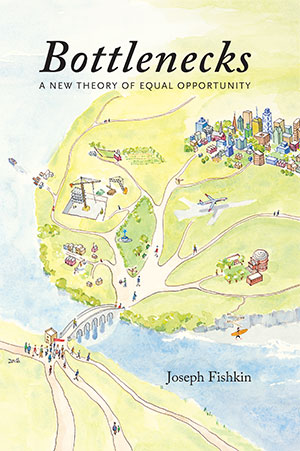 Assistant Professor Joseph Fishkin’s newly published book, “Bottlenecks: A New Theory of Equal Opportunity,” proposes ways of changing the opportunity structure to make it less constraining and less unequal. In the book, published in February by Oxford University Press, “bottlenecks” refer to narrow places through which one has to pass in order to reach many opportunities that open out on the other side. The following Q-and-A is an entry point into Fishkin’s contribution to the timely conversation happening now in contemporary politics and law about equal opportunity.
Assistant Professor Joseph Fishkin’s newly published book, “Bottlenecks: A New Theory of Equal Opportunity,” proposes ways of changing the opportunity structure to make it less constraining and less unequal. In the book, published in February by Oxford University Press, “bottlenecks” refer to narrow places through which one has to pass in order to reach many opportunities that open out on the other side. The following Q-and-A is an entry point into Fishkin’s contribution to the timely conversation happening now in contemporary politics and law about equal opportunity.
Which “bottleneck” in today’s society do you think deserves the most scrutiny?
I’d have to say class. There are lots of obvious bottlenecks we’ve all had to pass through in our own lives: the SAT, a college degree, the bar exam. But there are other bottlenecks that shape the opportunity structure in our society that don’t look like that. I think class is the most serious. Employers don’t go around saying “nobody who grew up poor need apply.” But in so many subtler ways than that, growing up wealthier opens up a lot of different paths in our society. That’s the sense in which class itself is a bottleneck, and it’s one that Americans are only beginning to grapple with.
Briefly describe “opportunity pluralism.” Why is this an important theory?
Opportunity pluralism is basically the idea that we ought to try to open up more opportunities to people — at all stages in life, not just in childhood — to pursue different paths to goals we value. As a theory, what’s new here is the turn away from thinking about literally equalizing opportunities. Literally equal just can’t be done. There are too many different kinds of opportunities that are valuable for different reasons. The practical import of opportunity pluralism is that it focuses our attention on a different set of questions. Not only, for instance, the question of should we have affirmative action in college admissions, but also why should college be only for 18-year-olds, why should it be so competitive and why should it be so expensive? Opportunity pluralism helps us see more of the constraints on people’s opportunities than we’d otherwise pay attention to, and it gives us a roadmap for how different institutions can respond.
How does anti-discrimination law come into play in your book?
Anti-discrimination law was built on the idea of protecting against discrimination on the basis of a short list of protected categories — race, sex, national origin and so on. But today, there are new anti-discrimination protections in many states and cities that aim to protect the employment prospects of people with a spotty credit history, a bout of unemployment or a past criminal conviction. Our usual ways of thinking about anti-discrimination law have trouble making sense of this. People with bad credit, for instance, aren’t a group with a long history of discrimination and exclusion. But I think we can understand these new laws as efforts to attack bottlenecks in the opportunity structure. When ex-convicts re-entering society can’t get any job at all, then we have a social problem: the bottleneck they face is too constraining (with the predictable result that with no way to make a living, some will return to crime). I argue in the book that this way of understanding anti-discrimination law — as a tool for ameliorating bottlenecks — can teach us a lot about how anti-discrimination law works in the more usual contexts of race and sex and so on.
As a law professor, how does your approach to researching and writing about equal opportunity differ from that of say, an economist?
In the book, I actually draw on a lot of studies by economists as well as sociologists, psychologists and even some biologists. But my own project is not empirical. I’m not studying a particular bottleneck or two and testing how difficult it is to get through. Instead, what I’m doing in the book is building a new framework for thinking about opportunity. Law professors like to think of ourselves as generalists, capable of learning about and drawing from many areas of law and public policy in our work. I may not always live up to that, but this book definitely does. The book’s argument has implications not only for anti-discrimination law, but also for education law and policy (both K-12 and higher), economic policy, health policy and a number of areas of social policy. This made writing it a lot of fun, and it meant I had to learn a lot along the way.
